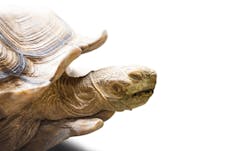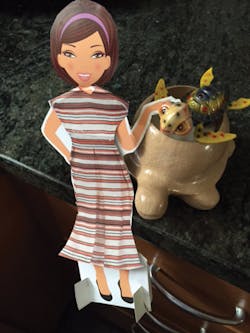The slow-moving turtle bears much in common with dental hygiene. It's not all about speed, you know?
BY Winnie Furnari, RDH, MS, FAADH
At a round table discussion during the American Dental Hygienists' Association annual meeting, a student wore a gem-encrusted turtle charm necklace that sparked a conversation. The hygienist asked her why she wore a turtle. She revealed her enthusiasm and love of turtles and that she had an extensive collection. The hygienist asked her if she knew the turtle was the mascot of dental hygiene. Surprisingly, she said she had heard that and agreed that it should be shared and others should know about the special connection that turtles and hygienists have.
The year was 2007, and many hygienists at the ADHA President's Luncheon for Marge Green learned a very interesting fact. At the place setting was a small card with a tiny turtle attached. The following was written on the card: "Marge Green's program director at Columbia University, Patricia McLean, former ADHA president, told her that the mascot of dental hygiene was the turtle."
We always make progress moving forward cautiously, and we are never afraid to stick our neck out to take the necessary risks of moving forward. We are always well protected by the safe home surrounding us-our shell! Look at the story of "The Tortoise and the Hare." James Bryant Conant, who reformed Harvard University as its president in the 1930s and 1940s, was quoted as saying: "Behold the turtle. He makes progress only when he sticks his neck out."1 This was such an interesting revelation. I hold on to that card from the ADHA luncheon to this day because it became special.
I told students and colleagues that dental hygiene had a mascot, but was hard-pressed to find any more documentation about it. Where did it come from? When did this come about? Who knows, but it has been around for a while and so why not embrace it? I started collecting turtles as souvenirs. I have fond memories of my family always having a pet turtle until they were banned as household pets. It lived in a round plastic aquarium with a plastic palm tree. Every time one died, my mother would replace it. Her mom had always had a turtle as a child too. This was an omen that life would eventually cross paths with a turtle again.
Throughout the ages, humans have bestowed turtles with special meanings. The Life Balance Institute, which has a turtle as part of its corporate logo, tells us that ancient myths from different cultures describe the world as resting on the turtle's back. Among Far Eastern cultures, it was believed that the turtle's back symbolized Heaven and that its underside represented Earth. For them, the turtle signified the possibility of uniting Heaven and Earth within one's own life.
Some cultures today still regard the turtle as a symbol of the primal mother and believe that it is connected to the lunar cycle. Others associate the turtle with longevity and wisdom. Incredibly, sea turtles have existed on earth longer than any other vertebrate animal; they were here when dinosaurs evolved and became extinct, and they survived the Ice Age.
The California-based Life Balance Institute claims the turtle has qualities that are congruent with their teachings and values. The turtle naturally withdraws and goes within when in turmoil. It does not need to learn the importance of this focusing inward; it naturally knows.2
The Inner Peace Yoga Center claims, "The turtle's whole life is one of steadfastness, effort, and patience. Because of its seemingly wide-eyed, long-lived, carefree attitude, the turtle is often thought to be the wisest of souls among the animal kingdom."3
The Chi Eta Phi National Nursing Sorority boasts the turtle as persevering, sure-footed, purposely directed, and determined. "The turtle knows when to hold and when to fold. The turtle tends to move slowly but steadily toward the goal. It tends to constantly renew itself and tries to create an environment that supports and encourages. Turtles are risk-takers. They are calm movers and shakers who realize that life is but one long risk. Each time the turtle moves, it must stick its neck out. To implement change, we must be willing to move out of our protective shell and have the courage and the confidence to encourage and support creativity and innovation."8
A few sport entities such as the basketball teams of the University of Maryland, the Santa Cruz Warriors, and Daytona Beach Tortugas (baseball) use the turtle as their mascots. The Rhode Island Hospital uses a turtle, as does the Branno paint company. Smucker's ice cream topping once used it.
While visiting exhibitors at the 2015 RDH Under One Roof Event, I found no less than four companies who have a turtle to be found in their products: Colgate has the Teenage Mutant Ninja Turtles toothbrush line. Denticator, in their Zooby line, has Toby the Turtle on a patient bib and will have him on new prophy angles next spring. Shofu depicts the strong shell of the turtle in its ad for PRG Barrier Coat Varnish, and PHB/Prophy Perfect/Preventive Dental Specialties offers a baby toothbrush Bite-n-Clean turtle.
Fans of turtles can join them on social media communities such as The Turtles of Western Highway (Facebook) and join groups such as the New York Turtle and Tortoise Society. There are towns and resorts that also capitalize on using the turtle as a mascot.
The turtle is uniquely designed, as is dental hygiene. A group of turtles is called a "turn," and the dental hygiene "turn" will progress forward. The time is right for a campaign to promote our mascot by sticking our necks out for dental hygiene. Although many species of turtles are endangered, there are groups who will collaborate to protect them. These are the ordinary people of the world who are working together to protect turtles and their habitats. Both the Audubon Nature Institute and the SWOT group welcome anyone with interest.
So, through never being afraid to stick our necks out, moving cautiously, and through collaboration with others, dental hygiene will persevere, as has our mascot for millions of years. Wear a turtle with pride. RDH
Anecdotes and facts about turtles to consider
The turtle has symbolism. It is associated with the earth symbols of roundedness and patience; of determination, persistence, emotional strength, understanding, ancient wisdom, and the ability to stay rounded, even in moments of disturbances and patience.4
The turtle has totem teachings. It symbolizes the path we take as we embark on our journey through life. The way of the turtle anchors our personal unfolding in a slow, more grounded series of steps and longer cycles of transformation.4
The turtle has ancient wisdom. It teaches us about determination and staying strong despite obstacles or distractions. It encourages those to trust in their path no matter what.4
Turtles don't have teeth as we know them. They have upper and lower jaws covered by horny ridges. Carnivorous turtles have knifelike sharp ridges.5
Dental hygiene is not alone in using the turtle as a mascot. It is in good company. Eighteen states (Alabama, California, Colorado, Florida, Georgia, Illinois, Kansas, Maryland, Michigan, Minnesota, Missouri, Nevada, New York, North Carolina, South Carolina, Tennessee, Texas, and Vermont) have declared the turtle as their state reptile.6 The U.S. Federal Trade Commission uses Dewie the Turtle to represent their safety and security initiative.7
Winnie Furnari, RDH, MS, FAADH, is a past president of the New Jersey Dental Hygienists' Association and the Dental Hygienists' Association of the State of New York. She is an associate professor at New York University College of Dentistry and teaches Forensic Dentistry/Bioterrorism Preparedness for dental hygienists in the baccalaureate program and through continuing education presentations. She was awarded the Pfizer/ADHA Award of Excellence, the ADHA Distinguished Service Award, the Philips/RDH Mentor of Distinction, and both national and international recognition for her forensic work. As a member of the New York City Dental Identification Team, she has participated in several multiple fatality responses.
References
1. James Bryant Conant Quotes. Available at www.goodreads.com/quotes/15918
2. Why is the turtle in our logo? Life Balance Institute. Available at www.lifebalanceinstitute.com
3. Inner Peace Yoga. Available at www.innerpeaceyoga.ca/turtle.php
4. Spirit animals and totem animals. Available at www.spiritanimal.info/turtle-spirit-animal
5. Welcome to all turtles. Available at www.allturtles.com
6. State Symbols USA. Available at www.statesymbolsusa.org
7. Creating a Culture of Security. Available at https://www.ftc.gov/public-statements/2002/09/creating-culture-security
8. Chi Eta Phi Sorority, Inc. Available at www.chietaphi.com








